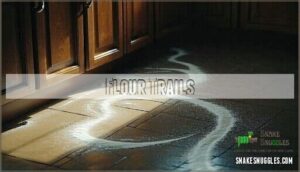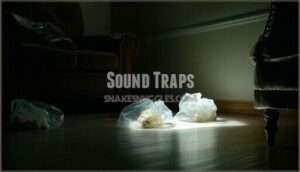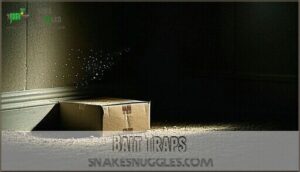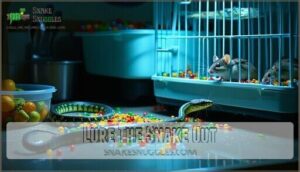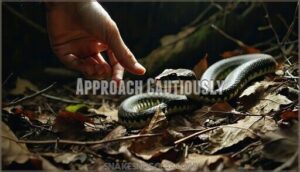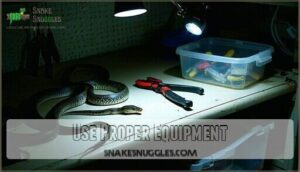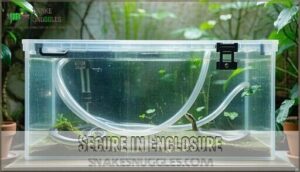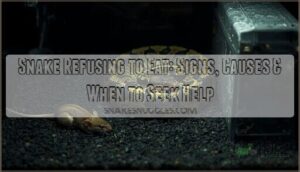This site is supported by our readers. We may earn a commission, at no cost to you, if you purchase through links.
 When your snake escaped from its cage, don’t panic.
When your snake escaped from its cage, don’t panic.
Start searching immediately near the enclosure since most snakes don’t travel far from their comfort zone.
Secure other pets in separate rooms to avoid spooking your missing reptile.
Check behind furniture, inside appliances, and tight spaces where snakes naturally seek shelter.
Set up flour trails to track movement patterns and place heat sources like heating pads in quiet areas.
Your escaped snake is likely hiding somewhere warm and dark within your home.
Most pet snakes lack the survival instincts for outdoor life, so they’ll stick close to familiar territory.
The key lies in understanding their behavior patterns.
Table Of Contents
- Key Takeaways
- Stay Calm
- Initial Search
- Expand Search Area
- Set Up Traps
- Prevent Future Escapes
- Lure The Snake Out
- Handling a Found Snake
- When to Seek Help
- Frequently Asked Questions (FAQs)
- How do I find my escaped snake?
- How do you attract an escaped snake?
- Can snakes escape their cage?
- How to lure a snake out of hiding?
- What to do if a snake gets out of a cage?
- Where would my snake hide if he escaped?
- Where do snakes go when they get out of their cage?
- How long can a snake survive without food?
- Can snakes climb vertical surfaces or walls?
- What if the snake gets into plumbing?
- Conclusion
Key Takeaways
- Start searching immediately near the enclosure – Most escaped snakes don’t travel far from their comfort zone, so focus your initial search on floor-level spots behind furniture, along baseboards, and in warm areas within the same room as their cage.
- Use heat and bait to lure them out – Set up heating pads with hide boxes along walls, place thawed rodents as bait near suspected hiding spots, and create warm basking areas since cold-blooded snakes can’t resist heat sources.
- Check appliances and tight spaces systematically – Your snake will gravitate toward warm spots behind refrigerators, dryers, and other electronics, plus they’ll squeeze into gaps and crevices you’d never imagine possible.
- Secure your enclosure to prevent future escapes – Invest in quality locking mechanisms, seal gaps around your tank, and regularly inspect for weak spots since prevention beats chasing your snake through the house again.
Stay Calm
First, stay calm when you discover your snake escape.
Panic clouds judgment and leads to hasty decisions that waste precious time.
Stay methodical, not frantic—your snake needs your clear thinking, not your chaos.
Clear thinking helps you search methodically rather than frantically tearing apart rooms.
Avoid hasty actions like moving heavy furniture randomly.
Stay focused on systematic searching techniques.
A positive mindset reminds you that most snake hiding situations resolve successfully with patience.
Understanding instinctual hunting behaviors can help predict where your snake might be hiding.
Initial Search
When your snake escapes, you’ll need to start your search immediately in the most likely hiding spots.
Begin by checking the enclosure thoroughly, then inspect the room where the vivarium sits, focusing on areas behind furniture and along baseboards where snakes naturally move.
Check Enclosure
Before panicking, check your snake enclosure thoroughly for hiding spots you might’ve missed.
Examine behind fixtures, inside substrate, and every corner for design flaws or loose locking mechanisms. Your snake might still be there, tucked away in a decoration or under bedding.
Cage integrity issues like poor ventilation needs can also reveal enclosure security problems that allowed escape. Regularly checking the enclosure’s structural integrity can prevent future incidents.
Inspect Rooms
After checking the enclosure, methodically inspect rooms where your snake could be hiding.
Snakes gravitate toward floor level spots near walls, seeking security and warmth.
Focus your search on these strategic hiding places:
- Check behind furniture against walls where snakes feel protected
- Examine warm areas near heating vents or sunny windows
- Inspect cracks and crevices along baseboards and corners
- Search tight spaces under beds, dressers, and low furniture
- Look inside storage boxes, laundry baskets, and open containers to find your snake in strategic hiding places, ensuring you cover all areas where they might seek warmth.
Look Behind Furniture
Dust bunnies aren’t your only concern when checking behind furniture.
Your snake’s size determines which furniture types offer suitable hiding places.
Pull couches away from walls and examine underneath using different search angles.
Check limited access areas behind bookcases and dressers.
These snake hiding spots require thorough inspection.
Use a flashlight to illuminate dark spaces where your escaped pet might be coiled.
Expand Search Area
If your initial room search hasn’t turned up your escaped snake, you’ll need to expand your hunt to areas throughout your home where snakes naturally seek shelter.
Focus your search on warm spots near appliances, dark cabinet interiors, and tight spaces where your snake’s flexible body can squeeze through openings you mightn’t expect.
Check Appliances
Head straight to your appliances – they’re snake magnets because of their warmth.
Check behind your fridge motor and cooker where escaped snakes love hiding.
Dryer vents offer perfect snake hiding spots too.
Unplug everything first for safety, then use a flashlight to peer into tight spaces.
Warm electronics create ideal appliance heat sources that draw cold-blooded pets seeking comfort.
Examine Cabinets
After covering appliances, shift your focus to cabinets throughout your home.
Kitchen cabinets and bathroom cabinets offer perfect snake hiding places with their dark, enclosed spaces. Your escaped friend might be coiled behind cleaning supplies under sinks or nestled among stored items.
- Remove cabinet contents systematically to inspect every corner
- Check drawer inspection areas for gaps or openings
- Examine under sinks where pipes create additional hiding spots
Inspect Tight Spaces
Your snake’s disappearing act means serious crevice examination time.
Check flooring cracks, behind fixtures, and under appliances like washers and dryers.
Peek inside drawers and examine nooks and crannies around baseboards and door frames.
Use a flashlight to inspect tight spaces behind furniture and plumbing.
These hiding places are snake magnets – they’ll squeeze into gaps you’d never imagine possible.
Set Up Traps
When your snake doesn’t respond to direct searching, you’ll need to set up detection and capture systems throughout your home.
These traps work by tracking your snake’s movement patterns and creating opportunities to safely contain it when it emerges from hiding, using capture systems to ensure a safe retrieval.
Flour Trails
Detection becomes your best friend when flour trails reveal your escaped snake’s secret movements.
Sprinkle flour or cornstarch across doorways and along baseboards where your pet might travel. Check for slithery tracks after several hours. Using unscented flour in bulk can be an effective strategy.
- Flour Consistency: Use fine, unscented flour for clear track visibility
- Trail Placement: Focus on doorways, baseboards, and suspected hiding areas
- Reading Tracks: Look for distinctive S-shaped patterns in morning inspections
- Alternative Powders: Try cornstarch or baby powder if flour isn’t available
Sound Traps
DIY sound traps turn you into a snake detective.
Crumple plastic grocery bags—the optimal bag type for maximum noise—and place them along walls where your escaped snake might travel.
Placement strategies focus on warm spots and furniture edges. Turn off all electronics, grab your flashlight, and listen carefully.
These traps detect snake hiding behavior through rustling sounds when your pet moves around. You can also purchase specialized snake sound detectors.
Bait Traps
Beyond sound detection, bait traps offer another effective snake lure method. Strategic trap placement along walls and corners increases trap effectiveness substantially. Use thawed rodents or fresh eggs as bait selection – their scent creates powerful snake lures that draw escapees from hiding spots. Consider using specialized snake traps for increased effectiveness.
- Relief floods through you when checking traps reveals your missing companion
- Heart-pounding excitement builds as you discover fresh signs near bait traps
- Pure joy overwhelms the moment you safely recover your beloved pet
Monitor traps frequently for best results.
Prevent Future Escapes
Once you’ve found your escaped snake, you’ll want to secure your enclosure to prevent another stressful search.
A proper escape-proof setup with reinforced locks and sealed gaps will keep your snake safely contained and give you peace of mind.
Secure Enclosure
Investing in quality locking mechanisms prevents future headaches.
Choose lockable glass terrariums with wire locks on sliding doors, or plastic enclosures with secure lids for smaller species.
Check that enclosure material has no gaps and ventilation security doesn’t compromise containment.
Adequate hiding spots reduce stress-induced escape attempts.
Regular maintenance of your secure enclosure beats chasing escapees through your house, which is a result of poor planning and not investing in quality locking mechanisms to prevent future headaches.
Block Potential Exits
Beyond securing your enclosure, you’ll need to snake-proof your entire home.
Think of it as creating a fortress against tiny Houdinis.
Seal gaps around pipes, vents, and electrical outlets using these proven methods:
- Caulk crevices around baseboards and wall joints where snakes squeeze through
- Weather stripping under doors prevents slithering escapes to other rooms
- Draft guards block gaps under exterior doors and windows effectively
- Steel wool stuffs larger holes that caulk can’t fill completely
Secure windows and inspect floorboards regularly for new openings.
Monitor Behavior
Watching your snake’s daily routine reveals escape reasons before trouble starts.
Notice stress signals like excessive climbing, glass surfing, or striking at the enclosure walls.
These activity patterns show your pet’s restless.
Understanding snake behavior and hiding preferences helps you address environmental needs early.
Monitor behavior changes closely—a content snake won’t attempt another snake escape adventure.
Lure The Snake Out
Instead of continuing your search through every room, you can use your snake’s natural instincts to bring it back to you.
Set up heat sources like heating pads near hiding spots and place fresh food bait around your home to create an irresistible trail that’ll guide your escaped pet out of its hiding place, using its natural instincts to follow the fresh food.
Use Heat Sources
Cold-blooded snakes can’t resist warmth, making heat your best snake lure. Set up strategic heating pad placement around suspected hiding spots, maintaining basking spot temperature between 85-95°F.
Infrared heat sources work exceptionally well for snake attraction.
- Place heating pads under hide boxes along walls
- Position heat lamps near potential snake temperature zones
- Use seasonal adjustments – increase heat during winter searches
- Make certain heat source safety with timers and temperature control devices
Your escaped snake will likely investigate these warm zones within hours.
Place Food Bait
Food bait works because your escaped snake still needs to eat.
Place thawed rodents near suspected hiding spots—most snakes show strong rodent preference over other options.
Egg temptation also works well for some species.
Bait freshness matters, so replace food every 24 hours.
Strategic trap placement along walls increases success.
Monitor consumption regularly to track your pet snake’s location.
Leave Enclosure Open
Beyond food bait, try leaving your escaped snake’s enclosure open with familiar hiding spots inside.
Your pet’s natural inclination may lead it back to recognize the familiar scent and comfortable environment.
This snake lure method allows easy re-entry and reduces stress through voluntary return.
Position the open habitat near where you last spotted your snake for best results.
Handling a Found Snake
When you spot your escaped snake, don’t grab it with bare hands or make sudden movements that could stress the animal.
Move slowly and use proper tools like snake hooks or thick gloves to safely guide your pet back into its secure enclosure, ensuring a safe and stress-free capture with thick gloves.
Approach Cautiously
When you spot your escaped snake, resist the urge to grab it immediately.
Observe behavior first to assess snake temperament before making contact. Move slowly and avoid startling snake with sudden gestures or loud noises.
A defensive posture means the snake is aggressive and stressed. Safe snake handling requires patience and understanding of the snake’s behavior.
Approach cautiously from the side, never directly overhead, to secure safely, using a gentle and calm approach to avoid startling the snake, which is crucial for successful handling.
Use Proper Equipment
Never attempt to grab your escaped snake with bare hands.
Professional snake capture requires proper equipment to guarantee safe snake handling and containment.
Gather these essential tools for effective snake rescue:
- Snake tongs or hooks – Maintain safe distance during capture
- Secure container – Use a ventilated box with locking mechanisms
- Flashlight or selfie stick – Inspect tight spaces and guide movement
This equipment prevents injuries during snake containment operations.
Always prioritize puncture-resistant gloves for hand protection.
Secure in Enclosure
After capturing your snake with proper equipment, you’ll need to secure it immediately.
Check your enclosure for gaps or weak locking mechanisms before placing your pet inside. Use airline tubing to seal openings around glass lids.
Verify proper ventilation needs are met while maintaining temperature control. Add hiding spots for comfort.
Never use loose boards – invest in a secure enclosure with reliable snake escape prevention features.
When to Seek Help
You’ll need professional assistance when your snake stays missing after several days of searching.
Or shows signs of injury or illness after you find it.
Call a veterinarian immediately if your recovered snake appears lethargic, refuses food, or displays unusual behavior that suggests stress or health problems from its escape experience.
Snake Remains Missing
When your snake remains missing after days of searching, don’t lose hope.
Professional wildlife handlers excel at locating snakes in undetected exits and tight spaces that owners miss.
Long-term survival is possible if environmental factors like warmth and water exist.
False sightings can mislead your efforts.
Expert snake search techniques and specialized snake lure methods often succeed where standard snake trap types fail.
Snake is Aggressive
An aggressive snake poses serious risks during snake removal operations.
When your escaped pet displays defensive behaviors like striking or coiling, prioritize snake safety over immediate recapture. Professional handling techniques become necessary to avoid bites and reduce stress. A sudden change in temperament might indicate underlying health issues.
- Approach cautiously – Block escape routes while maintaining safe distance from agitated reptiles
- Use proper equipment – Snake hooks and tongs prevent direct contact during safe interaction
- Contact experts – Animal control professionals understand identifying triggers for successful capture
Snake is Injured
When your escaped snake surfaces with visible wounds, assess injuries immediately for severity.
Deep cuts, bleeding, or swelling require veterinary care within hours to prevent infection.
Don’t attempt pain management at home—professional treatment guarantees proper snake recovery.
Minor scrapes still need monitoring, but serious trauma demands urgent medical attention.
Your snake’s health depends on quick, professional intervention.
Frequently Asked Questions (FAQs)
How do I find my escaped snake?
Like a master magician vanishing into thin air, your slithery friend’s pulled the ultimate disappearing act.
Check hide boxes first, then search floor-level spots near walls.
Focus on warm areas behind appliances where they’ll likely coil up comfortably.
How do you attract an escaped snake?
Place warm hide boxes with heat pads along walls and baseboards.
Set up water bowls throughout your home. Use thawed rodents as bait near potential hiding spots.
Lower room temperature, then create warm basking areas to draw them out.
Can snakes escape their cage?
Absolutely, your serpent can pull a Houdini act!
Snakes are escape artists who exploit tiny gaps in cages.
They’ll squeeze through openings you’d never imagine possible, making secure enclosures with proper locks absolutely essential.
How to lure a snake out of hiding?
Heat works like a magnet for snakes.
Set up heating pads with hide boxes along walls, place warm water bowls around your home, and sprinkle flour trails to track movement patterns effectively.
What to do if a snake gets out of a cage?
First, don’t panic.
Check your snake’s enclosure thoroughly for escape routes. Search low areas, warm spots, and tight spaces systematically.
Set up heat sources with hiding boxes to lure them back.
Where would my snake hide if he escaped?
Like a shadow seeking shelter, your escaped snake will gravitate toward dark, warm hideouts.
Check behind appliances, under furniture, inside closets, and along baseboards.
They prefer tight spaces near heat sources and walls.
Where do snakes go when they get out of their cage?
Escaped snakes seek dark, warm hiding spots near walls and baseboards. They’ll squeeze behind furniture, under appliances, or into tight crevices. Check floor-level areas first since they rarely climb high.
How long can a snake survive without food?
Before smartphones existed, you’d think snakes needed daily meals, but they’re surprisingly resilient.
Your escaped snake can survive three to six months without eating, with some lasting up to nine months.
Can snakes climb vertical surfaces or walls?
Yes, snakes can climb vertical surfaces using their belly scales and muscular bodies.
They’ll scale textured walls, furniture, and even smooth surfaces if there’s enough grip.
Your escaped snake might be higher than you think, and this is an important consideration when searching for a missing pet.
What if the snake gets into plumbing?
Your plumbing’s about as snake-proof as a screen door, but don’t panic.
Most residential pipes are too narrow for snakes to navigate comfortably.
Check drain openings, seal gaps around pipes, and monitor for unusual sounds or blockages to ensure your plumbing system remains secure and snake-free.
Conclusion
Picture yourself breathing a sigh of relief as your missing serpent slithers back into familiar territory.
Finding a snake that’s escaped from cage requires patience, systematic searching, and understanding reptilian behavior patterns.
You’ll discover most escapees hide within twenty feet of their original enclosure, seeking warmth and security.
Remember to secure your habitat properly afterward—loose latches and gaps create future headaches.
Your methodical approach and these proven techniques will reunite you with your scaly companion quickly and safely.



